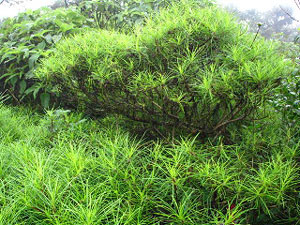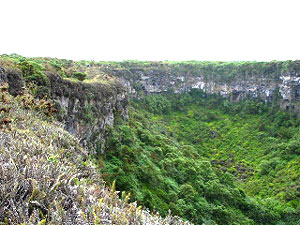

 | |||||||||||
|
|
Journals 2008/2009Tom Bogard
August 28, 2008 I met the three Botany Technicians in the morning at the Station's tienda for the trip to the Highlands to work on the plant survey. I am very excited to get out and experience some of the island. The vegetation on the island changes greatly with elevation. The lowlands are dry and desert-like; as you get higher the climate is wetter and the vegetation is much denser. This time of the year the highlands are almost continuously covered in fog-like mist called guara. Even though it never did rain, it was very wet. My clothes were almost soaked from hiking through the vegetation. It was very green - in contrast to the browns and darker colors of the lowlands. We made several stops counting, measuring, collecting samples, and plotting the locations of the different plant species with the GPS. One of the plants that we were surveying and collecting was Darwin's Thin Leaved Shrub (Darwiniothamus teavifolis). It is a very attractive shrub with leaves that are deeply cut. The specimens that were collected will be used to plant in a demonstration garden of native plants. The procedure was to walk a predetermined transect and look for the target species. One of the morning survey stops that we made was at a location called Los Gemelos. It is the site of two pit craters - evidence of the island's volcanic past. According to the signs, there are two theories of how they formed. One is that they are the remains of lava chambers that collapsed as the lava escaped through a side vent. The second is that they are the craters left from the main vent of a volcano. They were definitely very exciting to see. The Galapagos were formed as the Earth's crust moved over a hot spot - a plume of magma that is ascends in one place from the mantle. The Hawaiian Islands formed in the same way. After Los Gemelos we made a quick stop and then went to Buenavista - a small town that was home to one of the technicians - for lunch at a local restaurant. It was not like any restaurant that I had ever been to. It appeared to be a courtyard area just off a house on the edge of the town square. There were not any markings to indicate that it was a restaurant. It only had a few tables made from local trees with the ever-present resin chairs. Food was ordered and served from a single window and only one meal was on the menu - actually there was no menu at all, you ate what they served or you did not eat. The meal started with a great chicken and corn soup (most lunches and dinners started with soup) and was followed by a heaping plate of rice, chicken, vegetables, all in a gravy/sauce and was finished with a small desert. The food was excellent! There was more food than I could finish. The entire lunch cost a whole $2.50. I was honored that the people that I was with would take me to their local restaurant. Judging from the stares that I got from the children I am sure that I was probably the only non-native that had eaten there in a very long time. After lunch we went to a private preserve and hiked up the side of a vegetation covered cinder cone volcano. The owner of the preserve had cut a road up to the top of the volcano. We surveyed plants on the way up. At the top we were treated to an absolutely stunning panoramic view of parts of the island and the coast. We all stood there silently for a while just taking it all in. That evening I met Phillip a Lichenologist from Switzerland who is staying in the room next to mine. We walked into town and had dinner together. He is in the islands studying and sampling lichens in the various eco-regions and different islands. He is a very interesting person and is passionate about his work. It was inspiring to meet and talk to someone like him.
|
||||||||||

